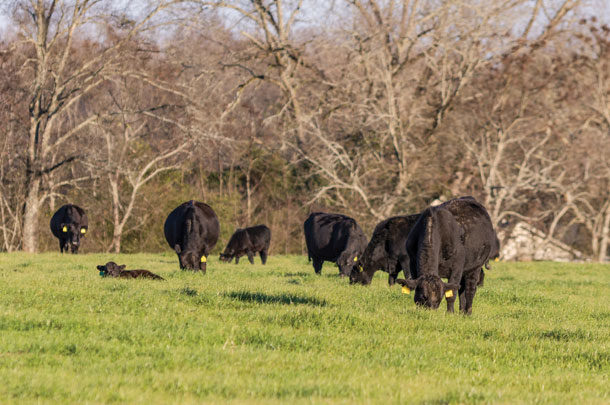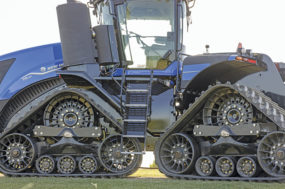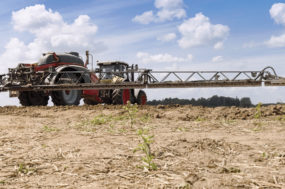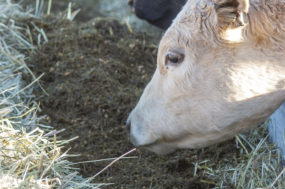Fischer Farms is an 1,100-acre cattle ranch and an all-natural meat, direct sales business. They market their meat to restaurants and retail stores across the region. All the beef is raised on their operation, where they aim to finish 650 head each year. Dave; his wife, Diana; his son Joseph; and his father, Joe, are all active members of the family farm and meat business.
While Dave grew up learning to farm from his father, he hasn’t always been a farmer. In 2002, after a successful 15-year career as a software consultant, Dave and his family made the decision to go back to the family farm. They were looking for a change of pace and the opportunity to raise their children near family.
Early on, Dave recognized that to make a go at farming he had to do things a little differently. He says, “To get a premium for our cattle’s genetics and our natural feeding program, I knew we couldn’t rely on the cattle cycle.” He says one night at a dinner party, friends commented on the taste and quality of the steak they served. Of course, it was from Dave’s own herd. This got Dave thinking, and soon the operation transitioned to direct meat sales. He says, “The first year I visited 17 restaurants; I had one that said yes. That one yes got us our start.” Today, they sell their product to 100-plus locations throughout Indiana.
Unique forage management
It’s not just the way they sell their product that makes Fischer Farms unique. One of Fischer Farms’ ingredients to success is rye – ryegrass, that is.
Ryegrass is the key component of their annual crop rotation. Dave says when he first came back to the farm, they planted everything into permanent pasture. They purchased the corn silage they fed in the winter and for use in their finishing rations. When corn silage prices increased, a neighbor suggested growing a few fields in wheat and corn for grazing or baling, and silage. After a couple of years of that rotation, Dave experimented with ryegrass. It worked. It worked really well.
Today, their rotation starts in the fall with planting annual ryegrass once the corn silage is out of the field. With a wet fall, they can count on good growth of the crop. During the dry and cold days of winter, the cattle graze the ryegrass with silage supplementation. In March, the cattle will come off the rye and go onto the permanent fescue pasture. The ryegrass is then fertilized and left to grow until mid-May, when it is cut into windrows, allowed to wilt and then chopped for silage. The ryegrass fields are spread with manure, sprayed (to kill the ryegrass) and then no-till planted into corn silage. The corn will grow all summer and is chopped in August for silage, starting the rotation over again.
Dave says, “One of the most enjoyable parts of this for me is going out on a 50-degree day in January and almost seeing the rye growing. I love opening up a gap in the fence and turning the cows out into a section of grass that was a stand of corn six months before. It is a remarkable crop.” It’s not just the rye crop that is remarkable; the whole rotation is rather remarkable.
Dave estimates yields of 2 to 4 tons per acre in the ryegrass from October to March while the cattle winter graze. Once the ryegrass is chopped for silage, it yields 3 to 6 tons per acre. The corn silage yields an additional 24 to 30 tons per acre. So, in total, the three “crops” result in 26 to 36 tons per acre. The vast majority of their feed is produced directly on their farm because of this rotation.
Benefit to the soil
The switch from wheat to ryegrass was initially made to allow for greater flexibility in the spring. Dave also knew there would be some benefit to the soil, but he didn’t know the extent of that benefit. In 2017, Dr. Lloyd Murdock from the University of Kentucky visited Fischer Farms to complete some testing. They found that in the six years they managed the ryegrass rotation, the ryegrass had turned 14 inches of fragipan into subsoil. This change meant increased drought tolerance, improved organic matter and provided erosion protection to the fields.
The data is impressive, but Fischer Farms is not done experimenting with the best production practices available. Dave says, “This year, I am trying another experiment using FIXatioN clover planted between my rows of ryegrass on several test plots. It should grow about 2 feet tall, and we will graze it with the rye and then chop it for silage with the ryegrass. It should increase the yields, and the seed breeders estimate it will release 50 to 200 pounds of nitrogen per acre into the soil after it is killed.”
Benefit to the environment
This year, at the request of their local cattle association, Fischer Farms opened their operation to a field day. In preparation for the tour, they planted 23 different plots using a variety of methods they’d tried over the years. They invited their customers to attend the field day Friday, and Saturday was for fellow cattle producers.
Dave says, “As you can imagine, the conversations between the two days were quite different. We had our largest beef customer, Indiana University, there on Friday. The message I try to tell is that our operation is sustainable. Contrary to what they might hear, our cows are actually pulling carbon out of the air through their feed.”
Dave estimates that for every 1 pound of meat he sells, 5 pounds of carbon goes back into the ground. He says, “When you say that, some people get a shell-shocked look, but they can’t argue against my rationale. As an industry, I wish we could get the message out there: Agriculture is sustainable, and it is good for the environment.”
Beef on rye (grass that is) is more than a tasty sandwich. It is a production system for Fischer Farms that’s good for their cattle, good for their soil and good for the environment. ![]()
Getty Images.
Erica Louder is a freelance writer based in Idaho.












